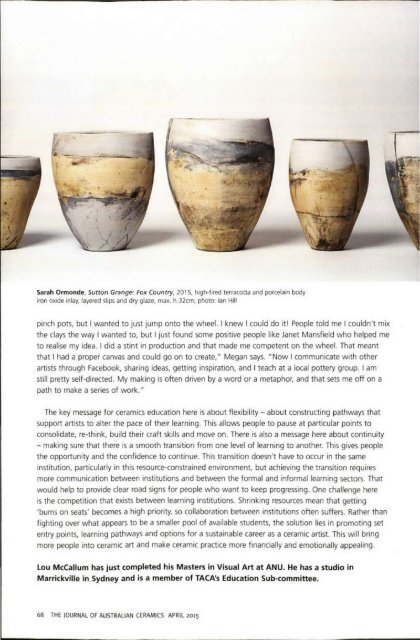The Journal of Australian Ceramics Vol 54 No 1 April 2015
Create successful ePaper yourself
Turn your PDF publications into a flip-book with our unique Google optimized e-Paper software.
Sarah Ormonde, Sutton Grange: Fox Co untry, <strong>2015</strong>, high*fired terracotta and porcelain body<br />
iron oxide inlay, layered slips and dry glaze, max. h.32cm; photo: Ian Hill<br />
pinch pots, but I wanted to just jump onto the wheel. I knew I could do it! People told me I couldn't mix<br />
the clays the way I wanted to, but I just found some positive people like Janet Mansfield who helped me<br />
to realise my idea. I did a stint in production and that made me competent on the wheel. That meant<br />
that I had a proper canvas and could go on to create," Megan says. "<strong>No</strong>w I communicate with other<br />
artists through Facebook, sharing ideas, getting inspiration, and I teach at a local pottery group. I am<br />
still pretty self-directed. My making is <strong>of</strong>ten driven by a word or a metaphor, and that sets me <strong>of</strong>f on a<br />
path to make a series <strong>of</strong> work. "<br />
<strong>The</strong> key message for ceram ics education here is about flexibility - about constructing pathways that<br />
support artists to alter the pace <strong>of</strong> their learning. This allows people to pause at particular points to<br />
consolidate, re-think, build their craft skills and move on. <strong>The</strong>re is also a message here about continuity<br />
- making sure that there is a smooth transition from one level <strong>of</strong> learn ing to another. This gives people<br />
the opportunity and the confidence to continue. This transition doesn't have to occur in the same<br />
institution, particularly in this resource-constrained environment, but achieving the transition requires<br />
more communication between institutions and between the formal and informal learn ing sectors. That<br />
would help to provide clear road signs for people who want to keep progressing. One challenge here<br />
is the competition that exists between learning institutions. Shrinking resources mean that getting<br />
'bums on seats' becomes a high priority, so collaboration between institutions <strong>of</strong>ten suffers. Rather than<br />
fighting over what appears to be a smaller pool <strong>of</strong> available students, the solution lies in promoting set<br />
entry points, learning pathways and options for a sustainable career as a ceramic artist. This will bring<br />
more people into ceramic art and make ceramic practice more financially and emotionally appealing .<br />
Lou McCallum has just completed his Masters in Visual Art at ANU. He has a studio in<br />
Marrickville in Sydney and is a member <strong>of</strong> TACA's Education Sub-committee.<br />
68 THE IOURNAL OF AUSTRALIAN CERAMICS APRIL <strong>2015</strong>

















